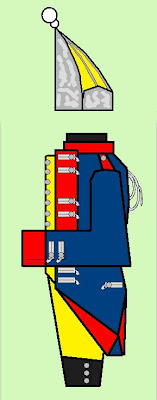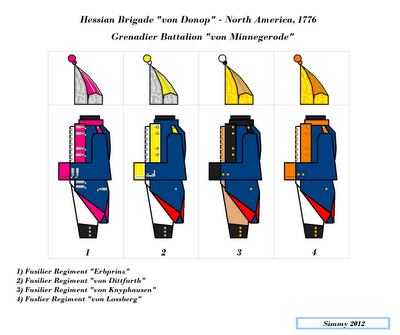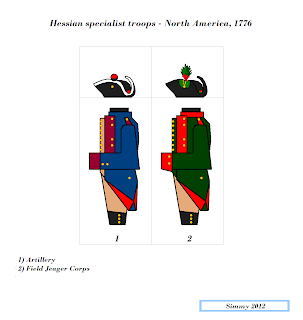 |
| 1° Regimento della Guardia - 1st Guard Regiment |
 |
| Bandiera del reggimento von Rall - Flag of Regiment von Rall |
GLI ASSIANI
La guerra contro i coloni americani era molto impopolare in Europa e nella stessa Gran Bretagna.
Per questo motivo gli inglesi avevano difficoltà a trovare nuove reclute per l’esercito che combatteva in America.
Una soluzione fu di stipulare degli accordi con alcuni principi tedeschi che tradizionalmente avevano fornito soldati ausiliari alla corona britannica nelle guerre precedenti, soprattutto l’elettorato d’Assia e il ducato di Brunswick.
I
soldati tedeschi che combatterono in America furono dipinti come violenti, ubriaconi e saccheggiatori, in realtà non erano peggiori degli altri combattenti, ma soprattutto non erano “vili mercenari” ma soldati fedeli al proprio principe, che a sua volta gli aveva “prestati” a Re Giorgio III dietro compenso. Molti di essi resteranno in America come coloni dopo la guerra.
Il primo trattato per assoldare truppe tedesche fu firmato dagli inglesi col duca di Brunswick, il secondo, quello più importante, con il Langravio di Assia-Cassel il 15 gennaio 1776.
Esso prevedeva l’invio in America di un corpo assiano di truppe ausiliarie composto di due divisioni di fanteria, Jäger e artiglieria. Circa 17.000 assiani su 300.000 abitanti combatterono in America.
La prima divisione agli ordini del tenente generale von Heister sbarcò a Staten Island il 15 agosto, in tempo per partecipare alla battaglia di Long Island, nei pressi di New York.
La seconda divisione arrivò a New York in ottobre.
La Divisione di von Heister che partecipò alla battaglia di Long Island (17 agosto 1776) era la seguente:
Brigata del maggior generale von Mirbach
Reggimento Fucilieri Lossberg
Reggimento Fucilieri Knyphausen
Reggimento Granatieri Rall
Brigata del maggior generale von Stirn
Reggimento Fucilieri Erbprinz (principe ereditario)
Reggimento Moschettieri Mirbach
Reggimento Moschettieri Donop
Brigata del colonnello von Donop
Battaglione Granatieri Linsingen
Battaglione Granatieri Minegerode
Battaglione Granatieri Block
In riserva a Staten Island (non partecipa allo scontro):
Brigata del colonnello von Lossberg
Reggimento Fucilieri Ditfurth
Reggimento Trumbach
 |
| Mappa della battaglia di Long Island 1776 - Map of Long Island Battle 1776 |
LA BATTAGLIA DI LONG ISLAND
A Long Island gli americani agli ordini del maggior generale Israel Putnam erano in inferiorità numerica, ma avevano alle loro spalle numerose posizioni in trincea.
Il piano del comandante in capo britannico Sir William Howe prevedeva un movimento a tenaglia.
L’ala destra agli ordini dello stesso Howe doveva eseguire un aggiramento sul fianco della sinistra americana. L’ala sinistra britannica doveva compiere un attacco diversivo sulla destra americana, mentre le truppe assiane di von Heister avevano l’ordine di attaccare al centro, per impedire che il nemico sfuggisse alla trappola dell’ala aggirante inglese.
In realtà il piano non funzionò completamente, fallendo l’accerchiamento dei “ribelli”.
Gli assiani iniziarono l’attacco in ritardo, poi avanzarono lentamente, ma inesorabilmente.
Nel frattempo le truppe dell’ala aggirante non riuscirono a sorprendere gli americani, perché l’artiglieria britannica sparò troppo presto, facendosi scoprire.
Gli americani iniziarono una precipitosa ritirata, inseguiti da von Heister.
Mentre britannici e assiani si ricongiungevano presso la Cortelyou House, il 5° reggimento del Maryland del colonnello Smallwood condusse un contrattacco per fermare i nemici e consentire agli amici di ritirarsi nelle trincee.
Il sacrificio del reggimento del Maryland permise all’esercito americano di salvarsi, perché Howe non volle attaccare frontalmente le trincee, ricordando la gravi perdite subite a Bunker Hill, l’anno precedente.
Howe temporeggiò fino al giorno dopo, ma nella notte il generale Washington aveva evacuato Long Island per mare, ritirandosi sull’isola di Manhattan.
I britannici avevano vinto la battaglia, ma non avevano distrutto l’esercito avversario.
Essi incolparono la lentezza delle truppe tedesche, per il fallimento del piano, ma anche loro avevano commesso numerosi errori.
In seguito le truppe assiane si distinsero nelle battaglie di White Plains e di Fort Washington.
Nel Natale del 1776 una brigata assiana fu sconfitta e fatta prigioniera da Washington a Trenton, dopo di che i generali britannici non si fidarono del tutto di queste truppe.
 |
Reggimento moschettieri Leib - Leib Musketeers Regiment
|
UNIFORMI
Al contrario di quello che si diceva un tempo, i soldati dell’Elettorato d’Assia erano ben disciplinati, ben addestrati e ben equipaggiati.
La fanteria operava in ordine chiuso ed era più adatta a combattere sui campi di battaglia europei piuttosto che in America.
Al contrario gli Jäger (Cacciatori o Fanteria Leggera) erano ottimi in schermaglia e nei combattimenti nei territori selvaggi dell’America del Nord.
L’esercito assiano indossava uniformi d’ispirazione prussiana: giubba blu (verde per gli Jäger) con polsini nel colore reggimentale. A volte erano presenti risvolti e/o colletto dello stesso colore dei polsini.
Il panciotto e i calzoni erano bianchi, gialli o color bufalo, secondo il reggimento.
I reggimenti si riconoscevano anche per l’eventuale presenza di alamari sulla giubba e dal colore dei bottoni.
Il copricapo dei reggimenti di moschettieri era il tricorno con gallone bianco e pompon nei colori reggimentali. Il cappello delle compagnie di granatieri e del reggimento von Rall era un’alta mitria in ottone o metallo bianco. I reggimenti Fucilieri portavano una mitria più bassa negli stessi materiali.
I soldati indossavano pantaloni di panno con alte ghette nere, oppure avevano calzoni lunghi di tela, in vari colori.
L’equipaggiamento era costituito da: giberna nera con bandoliera bianca, cinturone porta sciabola bianco, zaino a tracolla di pelle di vacca, tascapane di tela e borraccia metallica.
L’armamento consisteva nel moschetto con baionetta e in una corta sciabola.
Per le bandiere si può consultare il seguente articolo:
THE HESSIANS
The war against the American colonists was very unpopular in Europe and in Britain itself.
For this reason the British had trouble finding new recruits for the army that fought in America.
One solution was to enter into agreements with several German princes who had traditionally provided auxiliary troops to the British crown in previous wars, particularly the electorate of Hesse and the Duke of Brunswick.
The German soldiers who fought in America were portrayed as violent, drunks and thieves, were not really worse than other fighters, but most were not "cowardly mercenaries" but soldiers loyal to his prince, who in turn had "lent" to King George III for a fee. Many of them remain in America as settlers after the war.
The first treaty to hire German troops was signed by the British with the Duke of Brunswick, the second-most importantly, with the Landgrave of Hesse-Cassel, January 15, 1776.
It involved sending to America a body of Hessian auxiliary troops composed of two divisions of infantry, artillery and Jäger. About 17,000 Hessian of 300,000 inhabitants fought in America.
The first division under the command of Lieutenant General von Heister landed at Staten Island on August 15, in time to participate in the Battle of Long Island, near New York.
The second division arrived in New York in October.
The Division of von Heister who participated in the Battle of Long Island (August 17, 1776) was as follows:
Brigade of Major-General von Mirbach
Lossberg Fusilier Regiment
Knyphausen Fusilier Regiment
Rall Grenadier Regiment
Brigade of Major-General von Stirn
Erbprinz (Crown Prince) Fusilier Regiment
Mirbach Musketeers Regiment
Donop Musketeers Regiment
Brigade of Colonel von Donop
Linsingen Grenadier Battalion
Minegerode Grenadier Battalion
Block Grenadier Battalion
In reserve at Staten Island (not participating in the fight):
Brigade of Colonel von Lossberg
Rifle Regiment Ditfurth
Regiment Trumbach
THE BATTLE OF LONG ISLAND
On Long Island, the Americans under the command of Major General Israel Putnam were outnumbered, but they had behind them a number of positions in the trenches.
The plan of the British commander Sir William Howe provided a outflanking movement.
The right wing under the command of that Howe had to perform a bypass on the side of the American left. The British left wing had to make a diversionary attack on the American right, while Hessen troops of von Heister had orders to attack the center, to prevent the enemy from escaping the trap of the English outflanking wing.
In fact, the plan did not work completely, failing their encirclement of the "rebels".
The Hessian attack began late, then advanced slowly but surely.
Meanwhile the troops encircling the wing failed to surprise the Americans, because the British artillery fired too soon, making out.
The Americans began a hasty retreat, pursued by von Heister.
While British and Hessian are reunited at the Cortelyou House, 5 th Regiment of Colonel Smallwood of Maryland led a counterattack to stop the enemies and allow friends to retire in the trenches.
The sacrifice of the regiment of Maryland allowed the U.S. military to save himself because Howe did not want to attack frontally the trenches, pointing out the serious losses sustained at Bunker Hill, the previous year.
Howe temporized until the next day, but in the night General Washington had evacuated Long Island by sea, retiring on the island of Manhattan.
The British had won the battle, but they had not destroyed the enemy army.
They blamed the slowness of the German troops, the failure of the plan, but they had also committed many errors.
Following Hessen troops distinguished themselves in the battles of White Plains and Fort Washington.
In Christmas of 1776 a brigade Hesse was defeated and taken prisoner by Washington at Trenton, after which the British generals did not they trusted entirely to these troops.
 |
| Fuciliere del reggimento Lossberg - Fusilier of Lossberg Regiment |
 |
| "Fuciliere del reggimento Lossberg" di D. Troiani - "Fusilier of Lossberg Regiment" by D. Troiani |
UNIFORM
Contrary to what we used to say, the electorate of Hesse soldiers were well disciplined, well trained and well equipped.
The infantry operating in close order, and was more suited to fighting on the battlefields of Europe than in America.
In contrast, Jäger (Hunter or Light Infantry) were great in skirmish and battle in the wilds of North America.
The Hessian army wore uniforms of Prussian inspiration: blue coat (green for Jäger) with cuffs in regimental color. Sometimes there were lapels and / or collar of the same color of the cuffs.
The waistcoat and breeches were white, yellow or buff, according to the regiment.
The regiments are also recognized for the possible presence of laces on his coat and for the color of buttons.
The headgear of the regiments of musketeers was the three-cornered hat with white lace and pom-poms in regimental colors. The cap of the grenadier companies and von Rall regiment, was a high miter of brass or white metal. Fusilier regiments wore a miter lowest in the same materials.
The soldiers wore cloth trousers with high black gaiters, or had long trousers of cloth in various colors.
The equipment consisted of: black pouch with white bandolier, white saber belt carries, shoulder cowhide backpack, canvas haversack and metal canteen.
The armament consisted of musket with bayonet and a short sword.
For the flags you can see the following article:
 |
| Alfiere del reggimento Ditfurth - Standard-bearer, Fusilier Regiment von Ditfurth |
 |
| Mitria del reggimento Fucilieri von Knyphausen - Mitre-cap of Fusiler Regiment von Knyphausen |



































